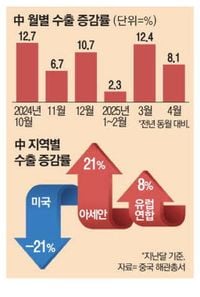China's latest trade figures reveal a surprising resilience in its export sector, with exports rising by 8.1% year-on-year in April 2025, despite the ongoing trade tensions with the United States. This increase, amounting to $315.69 billion, significantly outperformed analysts' expectations, who had predicted a modest growth of just 2%.
In recent years, the trade relationship between the two largest economies has been strained due to a series of punitive tariffs imposed by the U.S., some reaching as high as 145%. As a result, China has been forced to adapt its trade strategies, redirecting exports to Southeast Asia and other regions to mitigate the impact of these tariffs.
Data released by China’s customs authority indicates that exports to Southeast Asian nations surged by double digits, with notable increases of 21% to ASEAN countries and 8% to the European Union. This shift represents a structural repositioning of trade routes, as Stephen Innes of SPI Asset Management noted, "The global supply chain is being rerouted in real time." Vietnam, in particular, has emerged as a crucial hub for Chinese goods destined for the U.S., acting as an offshore outlet for exports.
Conversely, exports to the United States have plummeted, with a staggering 17.6% month-on-month decline, amounting to just $33 billion in April. This drop reflects the broader trend of decreasing trade between the two nations, which has seen exports to the U.S. fall by 21% year-on-year. The tariffs imposed by the U.S. have created significant barriers, leading to a sharp contraction in trade volumes.
As the trade war continues, analysts are cautious about the future of Chinese exports. Zhiwei Zhang, president and chief economist at Pinpoint Asset Management, cautioned that while the April figures are encouraging, they may not be sustainable. He attributed some of the export gains to trade contracts signed before the imposition of tariffs and warned that the impact of the tariffs would likely become more pronounced in the coming months. "If the U.S. continues to maintain high tariffs, China's exports to the U.S. this month could be 70-80% lower than a year ago," he stated.
Despite the challenges, the overall trade performance in April was bolstered by a smaller-than-expected decline in imports, which fell by only 0.2%, compared to the anticipated 6%. This suggests that domestic demand may be stabilizing, albeit slowly. To further stimulate the economy, Chinese authorities have introduced a series of monetary easing measures, including a reduction in key interest rates and lower reserve requirements for banks.
In a bid to support the housing market, the central bank announced a reduction in the interest rate for first-time homebuyers with loans exceeding five years, from 2.85% to 2.6%. These measures represent some of the most significant economic support initiatives since the previous September, aimed at addressing the ongoing crisis in the property sector, which has been a major engine of growth for the Chinese economy.
However, the persistent uncertainties surrounding U.S.-China trade relations continue to pose significant risks to recovery efforts. Gary Ng, senior economist for Asia Pacific at Natixis, emphasized that even if tariffs are reduced following upcoming trade talks, the ongoing uncertainty will continue to accelerate structural decoupling between the two economies.
These forthcoming negotiations, set to take place in Geneva on May 10, are the first high-level discussions since the trade war escalated. U.S. Treasury Secretary Scott Bessent and other senior trade officials are expected to meet with Chinese counterparts in hopes of reaching a de-escalation agreement. While there is optimism surrounding these talks, significant differences over strategic interests remain, which could hinder progress.
In the broader context, the trade figures from April highlight a significant transformation in global supply chains, as manufacturers seek to diversify their operations away from a reliance on China. The COVID-19 pandemic underscored the vulnerabilities of such dependencies, prompting a reevaluation of sourcing strategies.
Exports to regions outside the U.S. have seen notable growth, with shipments to Latin America and India both climbing by 11.5% and nearly 16%, respectively. Exports to Africa surged by 15%, while shipments to Vietnam and Thailand saw increases of 18% and 20%, respectively. This trend indicates that while China faces challenges with U.S. tariffs, it is also actively seeking new markets to bolster its export economy.
As the trade landscape continues to evolve, experts predict that China's export performance may face further declines in the coming months due to the cumulative effects of tariffs. The ongoing trade war, coupled with economic pressures at home, will likely shape the future of China's economy and its position in the global market.
In summary, while April's export figures provide a glimmer of hope for China's economy, the underlying challenges posed by U.S. tariffs and the uncertainty of future trade relations loom large. As both nations prepare for negotiations, the outcome will have significant implications for the global economy and the future of international trade.


